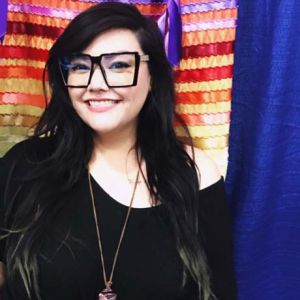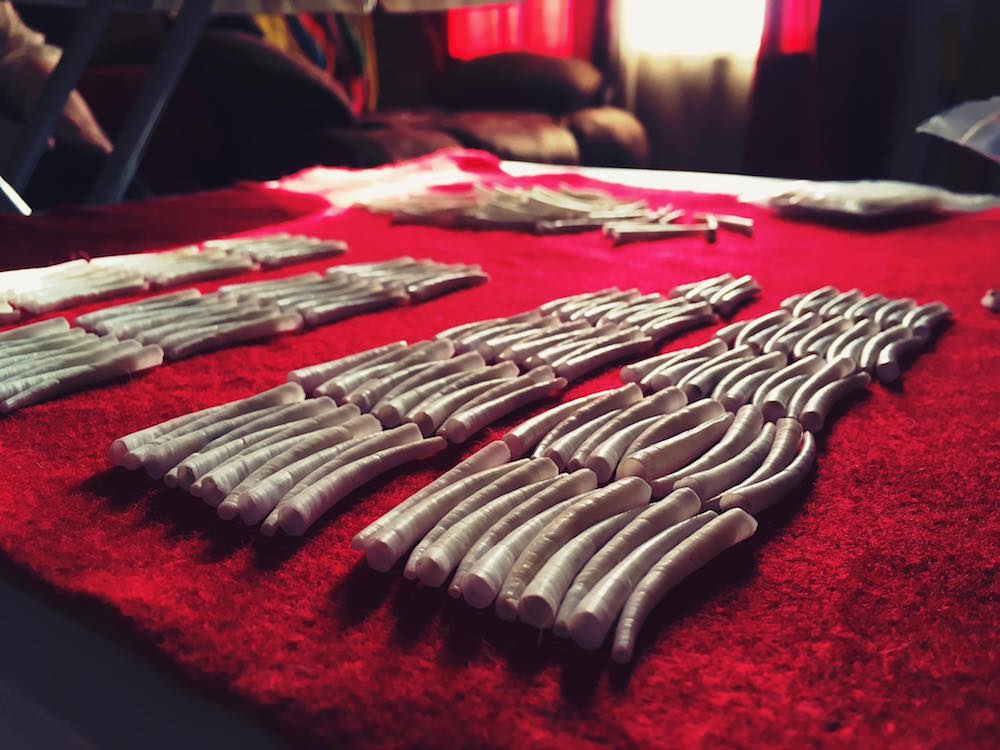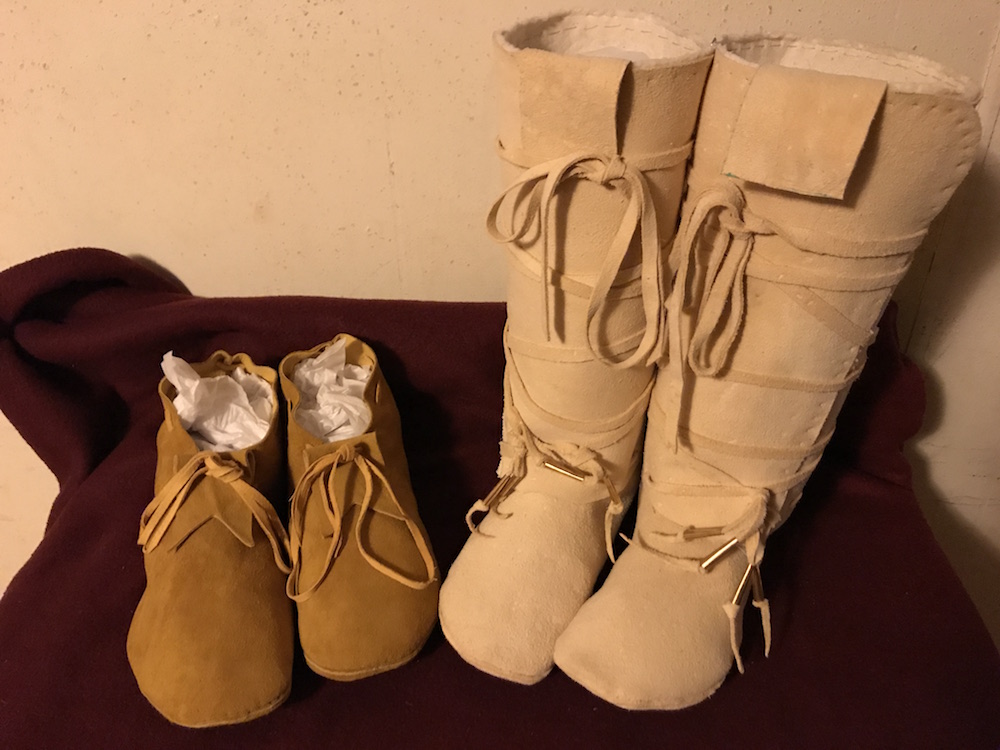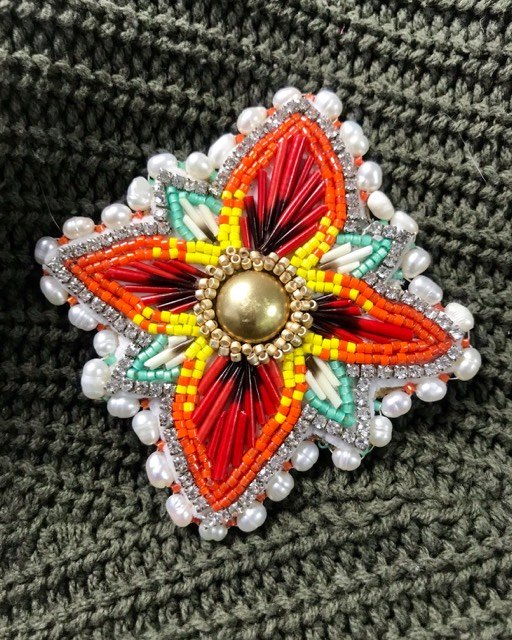Holly Doll is creating a Native-based art economy in rural North Dakota
This article is part of a series highlighting artists and leaders featured at the Rural Arts and Culture Summit, a biennial, practitioner-driven gathering hosted by Springboard for the Arts that celebrates and expands the field of rural arts-based community development. The 2019 Summit will take place October 3 – 5, 2019 at the Reif Center for Performing Arts in Grand Rapids, Minnesota. Learn more and register at www.ruralartsandculturesummit.
Holly Doll started learning beadwork from her mom when she was just two years old. She lives in Mandan, North Dakota, a city with a population just over 22,000 (near the capital city of Bismarck, population around 73,000). She is an enrolled member of the Standing Rock Sioux Tribe.
“Creating has always been part of my life,” she says. At age 16, she started to work with other Native artists at a nonprofit Native art gallery, Five Nations Arts, in the summer. Since she had grown up “off the rez,” this was the first time she really had a lot of exposure to and interaction with other Native artists outside of her family.
“Being at the gallery, I had a lot of contact with others in the Native community,” she says. “Because I grew up off the rez I felt that I had a slight disconnect. This really helped me feel more connected to my culture, and through that I came into contact with people who wanted to learn more about Native American culture. I found I really enjoyed working with my people as well as non-Native people who wanted to learn more.”
 After five years of working at the gallery, Doll became the manager. Around the same time, she formed the Native Artists United (NAU) co-op in December 2017. Then, as of December 26, 2018, NAU took over Five Nations Gallery, and Doll became the owner.
After five years of working at the gallery, Doll became the manager. Around the same time, she formed the Native Artists United (NAU) co-op in December 2017. Then, as of December 26, 2018, NAU took over Five Nations Gallery, and Doll became the owner.
“I knew I wanted to do more than have a storefront,” says Doll. She had been working with Dr. Cheryl Kary, executive director of the Sacred Pipe Resource Center, a nonprofit organization in Mandan aimed at helping Native American residents find resources for living and thriving in the area. Kary talked about the cooperative mentality and how it mirrors a lot of Native values, like working together as a collective towards a major goal.
“Everyone takes on responsibilities to work together as a whole,” Doll explains. “I had been playing with the idea of cooperative development all through 2018.”
She found 13 Native artists, including herself, to form the Native Artists United co-op. Through this co-op they do consignment through the gallery and Doll helps the other artists with professional development training, including training on how to build a portfolio and establish tax IDs.
“I try to encourage entrepreneurship rather than relying strictly on other people to do the work for them,” says Doll. “I really want them to realize they have a lot of potential if they choose to pursue [their art as a career].”
Although it’s a lot of work, she says, every once in awhile she finds someone who really benefits from it and is able to pursue their art professionally as entrepreneurs.
“My work is to educate around the need to increase market value, at least around the Plains,” she says. “The mentality before was, ‘I just made these on the side and am charging $20 for this pair of earrings even though it took me eight hours to make.’ We’re not getting what we should be for our work, so I do my best to do market value education—how to price their work is a big thing that I’ve really been focusing on in the last few months.”

With the co-op she works exclusively with Native artists based in North Dakota so that they can get all the benefits of the professional development training she has to offer. She found many of these artists through Five Nations, but any Native artist can work with Doll to sell their work through the NAU gallery on consignment; they just need to have some form of tribal identification.
But Doll doesn’t work exclusively with Native artists. She also does cultural sensitivity training for non-Natives who are curious and open to learn more about Native cultures. It started somewhat by accident: As the only Native art gallery in the Bismarck-Mandan area, Five Nations became the de facto Native cultural education center in the area, and Doll the de facto professor.
“I started with the graduate students who were stopping in wanting to know more about how to talk to their Native students,” says Doll. “Eventually I became the contact for cultural sensitivity and education, and I always included art with that. I wanted them to see the process of how to make a dream catcher rather than just showing them, so I made them do it themselves. That made more of an impact rather than just talking at them. I take the approach of having them be more interactive with me.”
Doll first really found herself in this role of accidental educator When the Dakota Access Pipeline protests were happening at Standing Rock. The protests brought so many people from all over the country to the area and Five Nations is located only 40 minutes away from Standing Rock, so people found their way over to her, and it opened her eyes to the tremendous need for such cultural education.
“Because mine was the only Native American art place in the area, people would come to me and have these really romanticized misconceptions about Native Plains artists and clumped us all together as a whole,” she says, so she began to educate them—one person or group after another, again and again and again.

“It does get a little exhausting. It’s a lot of emotional labor sometimes, but it’s really rewarding work and I enjoyed opening people’s eyes to the fact that each tribe is different in the Plains,” she says. “I really want to include cultural education from now on because I think it’s so important.”
Doll was invited to serve on the national advisory board for the Episcopal Church’s “Becoming Beloved Community” initiative and assisted with forming the grant application and reviewing grant submissions to fund nationwide racial healing programs. She was also contracted by George Washington University out of DC to be a coordinator for the North Dakota Native Tourism Alliance, for which she will co-facilitate community forums to help create tourism packages on the reservations, where a key role of NDNTA will be cultural education. She’ll also assist in more of the behind-the-scenes work, such as marketing plans, helping Native artists stabilize their business plans, and helping in the creation of the tour packages that are culturally respectful.
It’s important for outsiders to better understand these different Native cultures and learn more about them, but it is also important that such tours don’t end up gawking at tribal people living on reservations as if they were part of a human zoo. “I’m teaching cultural etiquette and what can be incorporated into these tourism packages before they even get on the rez,” Doll explains.
Doll also works with Invisible Innocence, an organization that combats human trafficking, to bring awareness through different pieces that they collaborate on with NAU.
All of Doll’s work, from the gallery to the co-op to her work as cultural educator, is connected through art and education.
“I’m trying to really push the education part before they attend any type of tour package,” see says. “I’m teaching them that they can’t make eye contact or take pictures without asking permission. It’s really just about being respectful. I’m pushing this education before they even step foot in the area, and I’m really trying to stress to them to approach this with an open heart, an open mind, and as much respect as they can muster.”
Doll feels that arts and culture are great ways to connect people, providing an ideal outlet for the education work she does.
“It brings out all sorts of feelings in people, and we share stories through it all,” she says. It’s probably the best way to form a connection with other people, especially in rural areas where one religion or ethnicity is really dominant. Having other people who can come in with a different experience and perspective just builds bridges.”
 Native Artists United officially formed as a cooperative in December 2018 when it took over the gallery. Prior to that, Doll had been working with a handful of the artists—predominantly Native women—on professional development, but also teaching them about the co-op structure. She says that member recruitment has always been a little bit slow for that reason—people just weren’t familiar with the concept of a co-op and it takes a lot of education on her part for them to understand it.
Native Artists United officially formed as a cooperative in December 2018 when it took over the gallery. Prior to that, Doll had been working with a handful of the artists—predominantly Native women—on professional development, but also teaching them about the co-op structure. She says that member recruitment has always been a little bit slow for that reason—people just weren’t familiar with the concept of a co-op and it takes a lot of education on her part for them to understand it.
“I definitely have had to chisel away at it for it to be what I wanted it to be,” she says. In the future, she’d like to have a larger dedicated space for professional development, including trainings and workshops on how to network and market, and also teach monthly classes on different Native arts techniques, both modern and traditional.
“Having a space to have all of that as well as my storefront would be perfect to have recognition statewide or beyond [North Dakota],” she says. “Just to have that reputation that I really want to help the community, both Native and non-Native. Growing up in Mandan there was really nothing for Natives, youths or adults, and it just made me sad. I really want to create something that I didn’t have growing up for futures generations to enjoy and experience, and have that connection again.”
Doll will present at the Rural Arts and Culture Summit at a breakout session called “Fighting for Visibility: Cultural Sensitivity Using the Language of Art,” which is about Native artists increasing value and awareness around their work, and how all of that ties back into traditional Native values.
“That’s where I pull a lot of inspiration from.”
Holly Doll is a Salzburg Global Fellow, part of the 2019 cohort of the Salzburg Global Forum for Young Cultural Innovators. Springboard for the Arts Associate Director Carl Atiya Swanson is also a Fellow, read his reflections on the Young Cultural Innovators Forum.
All photos provided by Holly Doll/Native Artists United.

(1) How do you like to collaborate?
I feel like with each person I collaborate differently. It’s more about how whoever I collaborate with, whether that’s one single artist or an organization—whatever feels comfortable for both of us. Some people are at a really large level of collaboration; I just want to go with what’s easiest for the other party and most beneficial for both of us.
(2) How do you a start a project?
Community feedback. Because I have the store, I get a lot of local people coming in and out and they always tell me, “I’d love to see you do this or that,” and if I hear it enough then I say, “Okay, this is something I need to do.” Or a lot of times I’ll see a need, that there’s a gap there—going back to seeing a cultural gap that needs to be filled.
(3) How do you talk about your value?
My vision statement for my organization is “to create a nation where Native art and culture is valued.” I really want the value that I’m bringing to the table to be getting people to value us.
(4) How do you define success?
I feel it when people thank me for anything I do for them, whether it’s on a small or large level. When they thank me and say, “I’m really proud of you,” I really like hearing that from my people. My mom will go around explaining what I do to other Natives and they’ll say, “I’m really proud of you.” That chokes me up sometimes.
(5) How do you fund your work?
My gallery brings in a small profit. I do charge a small fee for classes, and I charge a fee for speaking somewhere. My artists take special orders so money gets charged there—because it’s a co-op we have to maintain sustainability, so I do take five percent of profits for any event I pay for the artists to attend, and that goes back into the co-op’s fund for beads or potential events in future. I also have a fiscal sponsor who helps me get grants.
